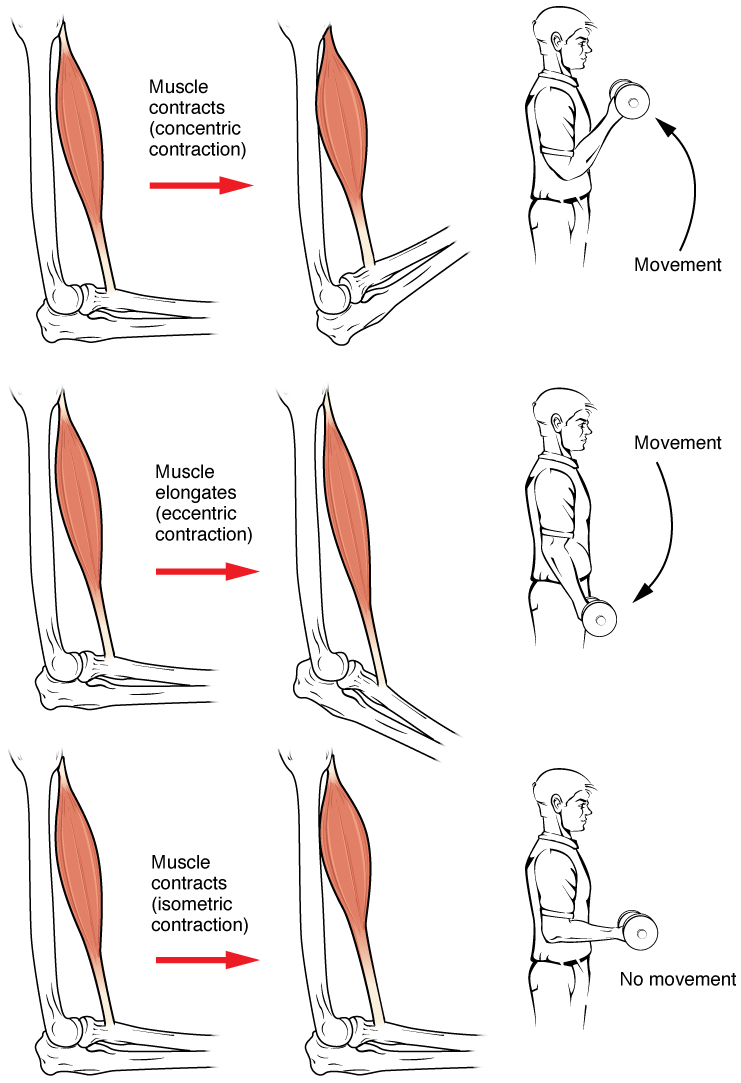
To move an object, referred to as a load, the muscle fibers of a skeletal muscle must shorten. The force generated by a contracting muscle is called muscle tension. Muscle tension can also be generated when the muscle is contracting against a load that does not move, resulting in two main types of skeletal muscle contractions: isotonic contractions and isometric contractions (Figure 10.4.1).

In isotonic contractions, where the tension in the muscle stays relatively constant, a load is moved as the length of the muscle changes. A concentric contraction involves the muscle producing tension and shortening to move a load. An example of this is the contraction of the biceps brachii muscle when a hand weight is brought upward toward the body. An eccentric contraction occurs when the muscle tension produced is less than the load and a muscle lengthens while under tension. This type of contraction is observed when the same hand weight is lowered in a slow and controlled manner by the biceps brachii. Both concentric and eccentric contractions involve force production by the muscle and crossbridge cycling with the myosin heads pulling toward the M-line. The only difference between the two is whether the muscle length is shortening or elongating during the contraction.
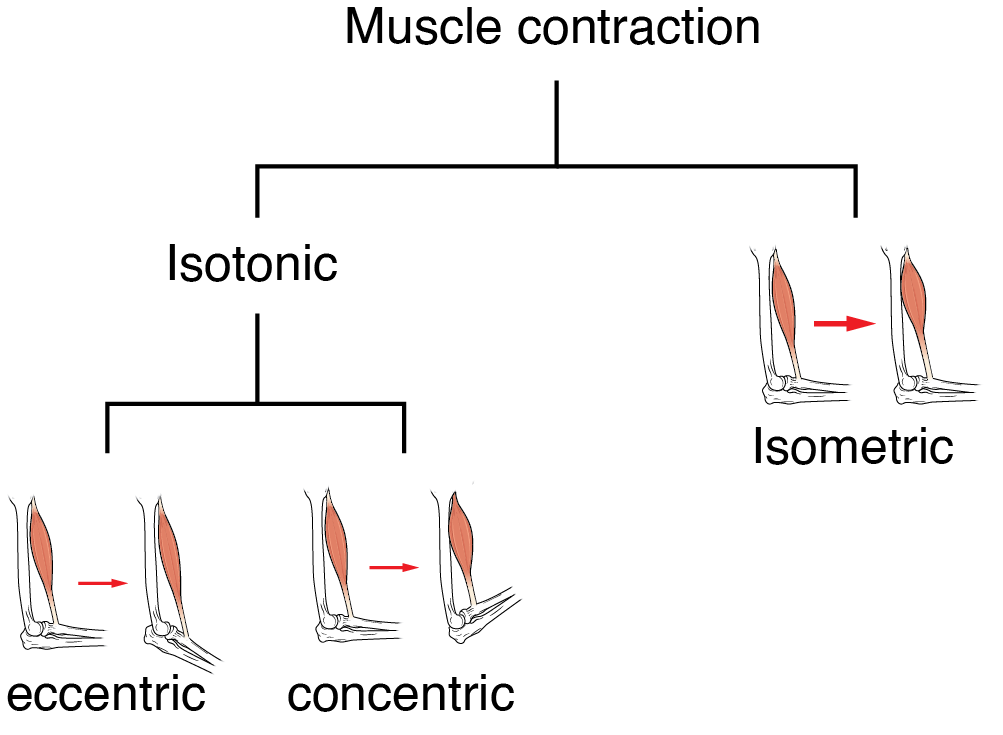
An isometric contraction occurs when a muscle produces tension without a change in muscle length. Isometric contractions involve sarcomere shortening and increasing muscle tension, but do not move a load, as the force produced cannot overcome the resistance provided by the load. For example, if one attempts to lift a hand weight that is too heavy, there will be sarcomere activation and shortening to a point, and ever-increasing muscle tension, but no change in the position of the hand weight. In everyday living, isometric contractions are active in maintaining posture and maintaining bone and joint stability.
Most actions of the body are the result of a combination of isotonic and isometric contractions working together to produce a wide range of outcomes. These muscle activities are under the control of the nervous system. A crucial aspect of nervous system control of skeletal muscles is the role of motor units.
As previously discussed, the contraction of skeletal muscle fibers is triggered by signaling from a motor neuron. Each muscle fiber is innervated by only one motor neuron but a single motor neuron can innervate multiple muscle fibers. A motor unit is defined a single motor neuron and all of the muscle fibers innervated by it (Figure 10.4.2b and Figure 10.4.2c).
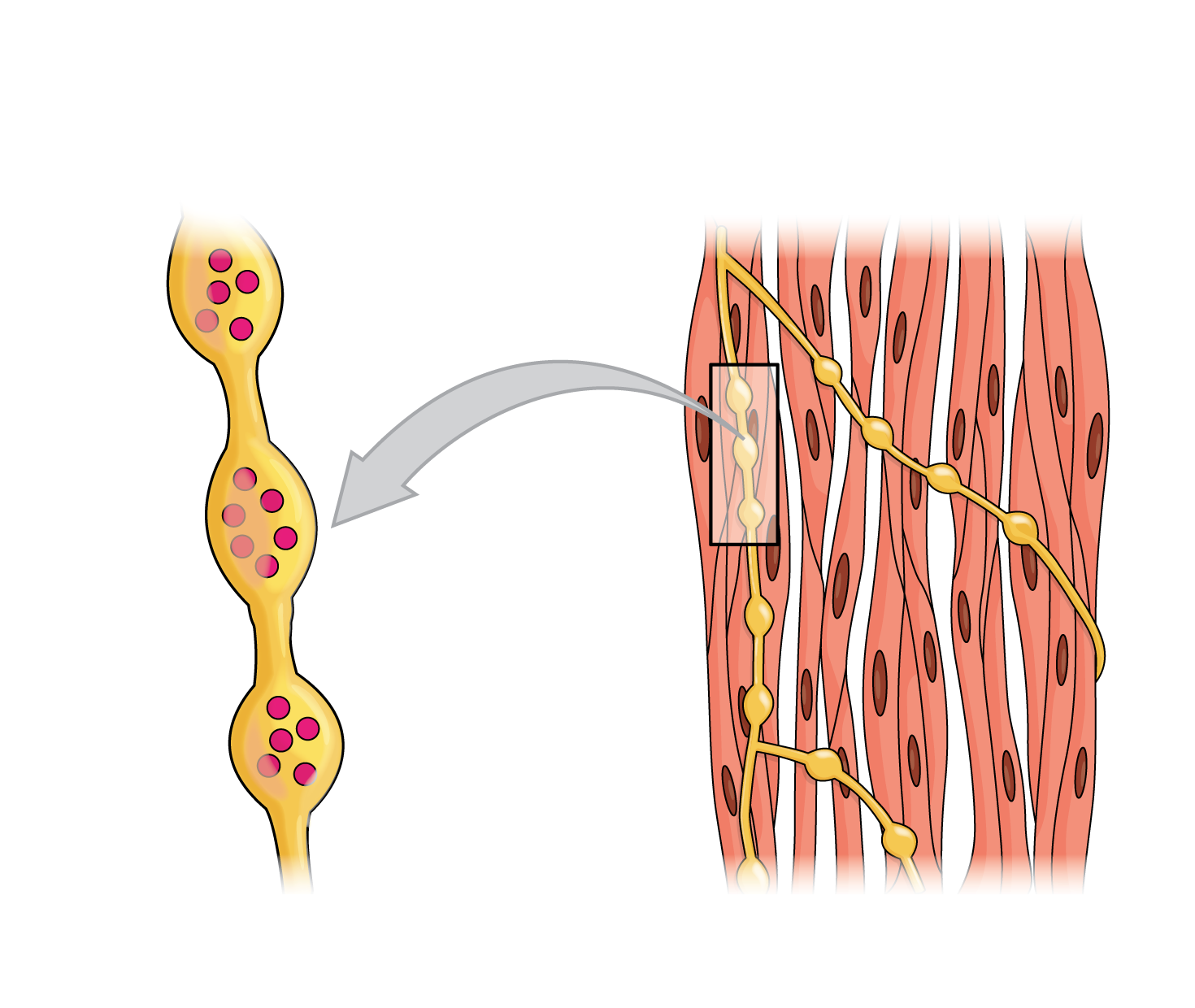
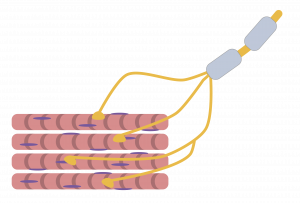
The size of a motor unit dictates its function. A small motor unit, composed of a motor neuron and only a few muscle fibers, permits very fine motor control of a muscle. For example, the extraocular eye muscles have thousands of muscle fibers with every 5 – 10 fibers supplied by a single motor neuron; this allows for exquisite control of eye movements so that both eyes can quickly focus on an object. Small motor units are also involved in the many fine movements of the fingers and thumb of the hand for grasping, texting, etc.
Large motor units have more muscle fibers per neuron than small motor units. Larger motor units are concerned with simple, or “gross,” movements, such as moving parts of the body against gravity. The large motor units of the thigh muscles or back muscles, where a single motor neuron will supply thousands of muscle fibers in a muscle, are representative of this type of activity.
Most muscles in the human body have a mixture of small and large motor units which gives the nervous system a wide range of control over the muscle. The smaller motor units in a muscle have motor neurons that are more excitable. Initial activation of these smaller motor units results in a relatively small degree of tension generated in a muscle. As more strength is needed, larger motor units are enlisted to generate more tension. This process of bringing on additional motor units to produce more tension is known as recruitment. This process allows a muscle such as the biceps brachii to pick up a feather with minimal force generation versus picking up a heavy weight which requires a much greater amount of force generation.
When necessary, the maximal number of motor units in a muscle can be recruited simultaneously, producing the maximum force of contraction for that muscle, but this cannot last for very long because of the energy requirements to sustain the contraction. To prevent complete muscle fatigue, motor units are generally not all simultaneously active, but instead some motor units rest while others are active, which allows for longer muscle contractions. The nervous system thus uses recruitment as a mechanism to efficiently utilize a skeletal muscle.
As discussed previously, when a skeletal muscle fiber contracts, myosin heads attach to actin to form cross-bridges followed by the thin filaments sliding over the thick filaments as the heads pull the actin, and this results in sarcomere shortening, creating the tension of the muscle contraction. The cross-bridges can only form where thin and thick filaments overlap; thus, the length of the sarcomere has a direct influence on the force generated when the sarcomere shortens. This is called the length-tension relationship.
The ideal length of a sarcomere to produce maximal tension occurs at 80 percent to 120 percent of its resting length, with 100 percent being the state where the medial edges of the thin filaments are just at the most-medial myosin heads of the thick filaments (Figure 10.4.4). This length maximizes the overlap of actin-binding sites and myosin heads.
If a sarcomere is stretched past the ideal length (beyond 120 percent), thick and thin filaments do not fully overlap, which results in less tension produced. If the muscle is stretched to the point where the thick and thin filaments do not overlap at all, no cross-bridges can be formed, and no tension is generated. This amount of stretching does not usually occur as accessory proteins and connective tissue oppose extreme stretching.
If a sarcomere is shortened beyond 80 percent, the zone of overlap is reduced with the thin filaments jutting beyond the last of the myosin heads. Eventually, there is nowhere else for the thin filaments to go and the amount of tension is diminished.
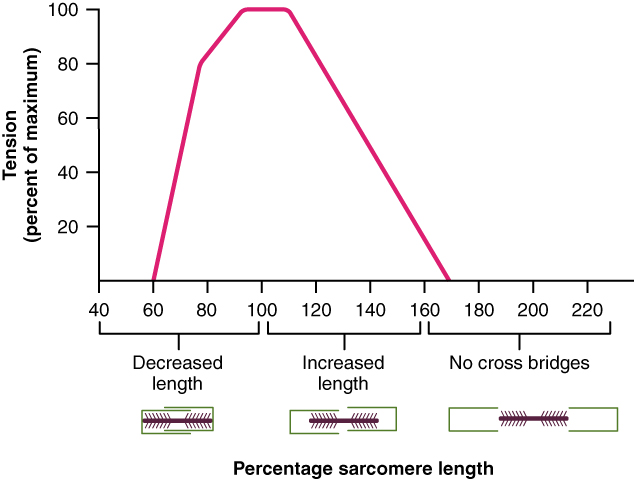
A single action potential from a motor neuron will produce a single contraction in the muscle fibers innervated by the motor neuron. This isolated contraction is called a twitch. A twitch can last anywhere from a few milliseconds to 100 milliseconds, depending on the muscle fiber type. The tension produced by a single twitch can be measured by a myogram, an instrument that measures the amount of tension produced over time (Figure 10.4.4).
Three phases are recognized for a muscle twitch. The first phase is the latent period, during which the action potential is being propagated along the sarcolemma and Ca ++ ions are released from the sarcoplasmic reticulum. This is the phase during which excitation and contraction are being coupled but contraction has yet to occur. The contraction phase occurs as the muscle generates increasing levels of tension; the Ca ++ ions in the sarcoplasm have bound to troponin, tropomyosin has shifted away from actin-binding sites, cross-bridges have formed, and sarcomeres are actively shortening. The last phase is the relaxation phase, when tension decreases as Ca ++ ions are pumped out of the sarcoplasm back into the sarcoplasmic reticulum, returning the muscle fibers to their resting state.
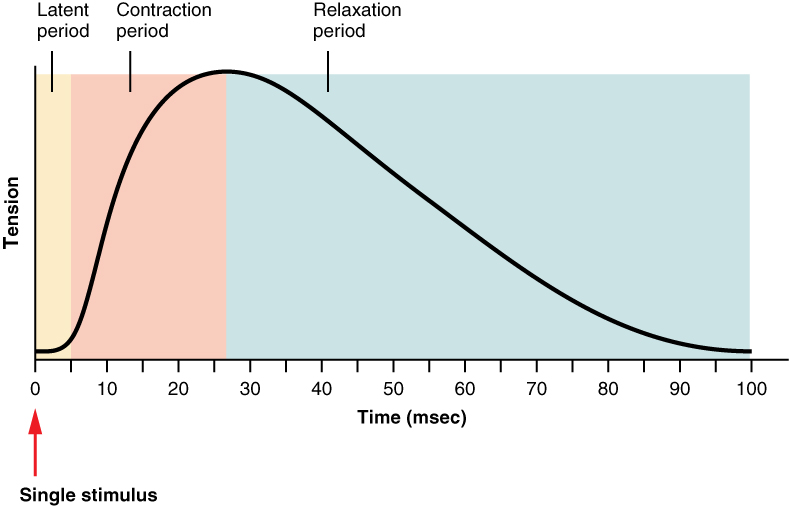
Although a person can experience a skeletal muscle “twitch,” a single twitch does not produce ‘useful’ activity in a living body. Instead, a rapid series of action potentials sent to the muscle fibers is necessary for a muscle contraction that can produce work. By varying the rate at which a motor neuron fires action potentials, the amount of tension generated by the innervated muscle fibers can be modified; this is called a graded muscle response.
A graded muscle response works as follows: if the fibers are stimulated while a previous twitch is still occurring, the second twitch will be stronger. This response is called wave summation, because the excitation-contraction coupling effects of successive motor neuron signaling is summed, or added together (Figure 10.4.5a). At the molecular level, summation occurs because the second stimulus triggers the release of more Ca ++ ions, which become available to activate more cross-bridging while the muscle is still contracting from the first stimulus. Summation results in greater contraction of the motor unit.
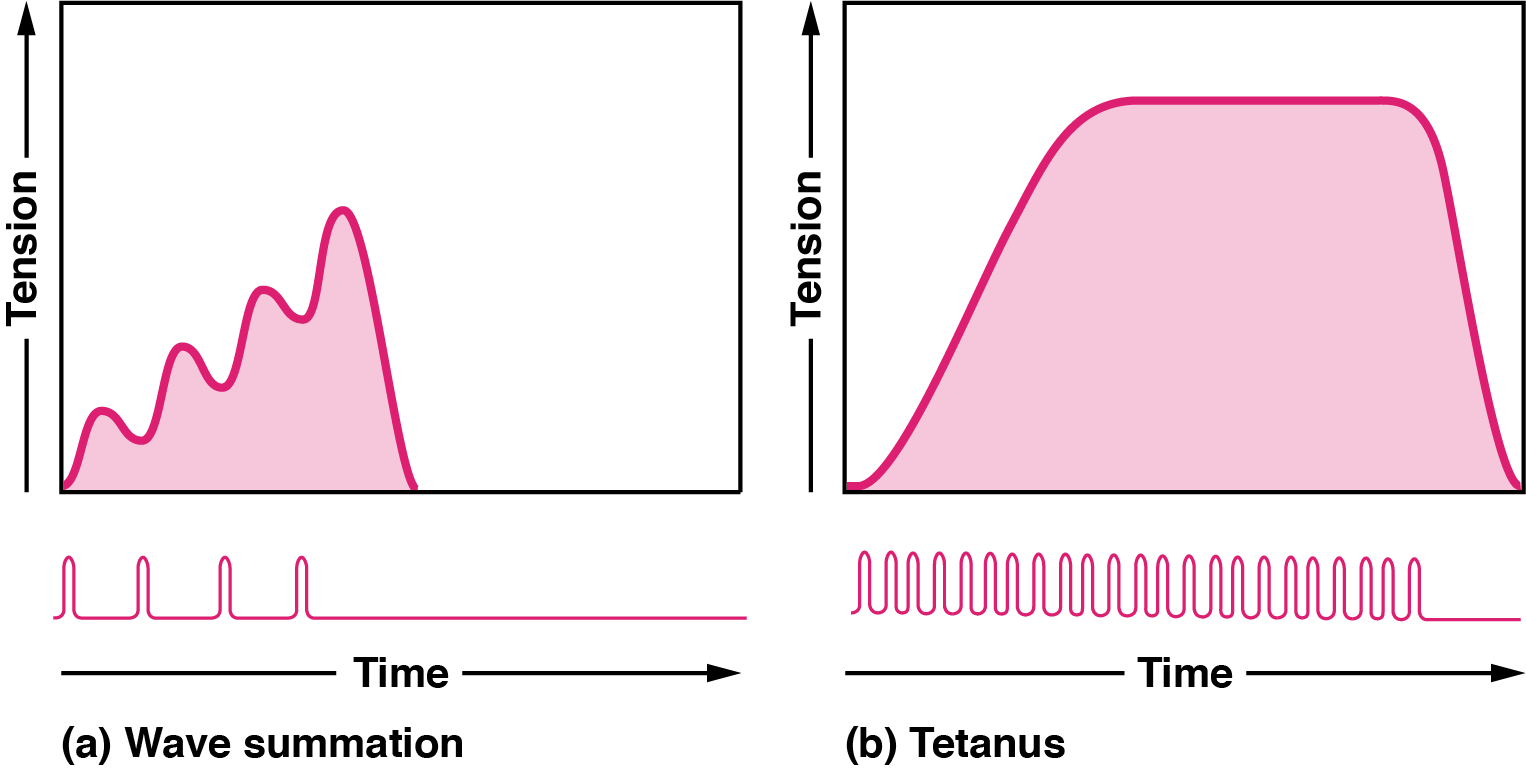
If the frequency of motor neuron signaling increases, summation and subsequent muscle tension in the motor unit continues to rise until it reaches a peak point. The tension at this point is about three to four times greater than the tension of a single twitch, a state referred to as incomplete tetanus. During incomplete tetanus, the muscle goes through quick cycles of contraction followed by a short relaxation phase. If the stimulus frequency is so high that the relaxation phase disappears completely, contractions become continuous in a process called complete tetanus (Figure 10.4.5b).
During complete tetanus, the concentration of Ca ++ ions in the sarcoplasm allows virtually all of the sarcomeres to form cross-bridges and shorten, so that a contraction can continue uninterrupted (until the muscle fatigues and can no longer produce tension).
When a skeletal muscle has been dormant for an extended period and then stimulated to contract, with all other things being equal, the initial contractions generate about one-half the force of later contractions. The muscle tension increases in a graded manner that to some looks like a set of stairs. This tension increase is called treppe, a condition where muscle contractions become more efficient. It’s also known as the “staircase effect” (Figure 10.4.5).
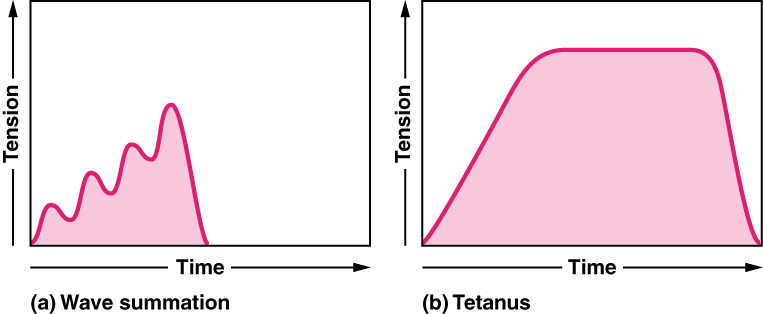
It is believed that treppe results from a higher concentration of Ca ++ in the sarcoplasm resulting from the steady stream of signals from the motor neuron. It can only be maintained with adequate ATP.
Skeletal muscles are rarely completely relaxed, or flaccid. Even if a muscle is not producing movement, it is contracted a small amount to maintain its contractile proteins and produce muscle tone. The tension produced by muscle tone allows muscles to continually stabilize joints and maintain posture.
Muscle tone is accomplished by a complex interaction between the nervous system and skeletal muscles that results in the activation of a few motor units at a time, most likely in a cyclical manner. In this manner, muscles never fatigue completely, as some motor units are in a state of recovery while others are actively generating tension.
Disorders of the…muscles: Hypotonia
The absence of the low-level contractions that lead to muscle tone is referred to as hypotonia or atrophy, and can result from damage to parts of the central nervous system (CNS), such as the cerebellum, or from loss of innervations to a skeletal muscle, as in poliomyelitis. Hypotonic muscles have a flaccid appearance and display functional impairments, such as weak reflexes. Conversely, excessive muscle tone is referred to as hypertonia, accompanied by hyperreflexia (excessive reflex responses), often the result of damage to upper motor neurons in the CNS. Hypertonia can present with muscle rigidity (as seen in Parkinson’s disease) or spasticity, a phasic change in muscle tone, where a limb will “snap” back from passive stretching (as seen in some strokes).
The number of cross-bridges formed between actin and myosin determines the amount of tension produced by a muscle. The length of a sarcomere is optimal when the zone of overlap between thin and thick filaments is greatest. Muscles that are stretched or compressed too greatly do not produce maximal amounts of power. A motor unit is formed by a motor neuron and all of the muscle fibers that are innervated by that same motor neuron. A single contraction is called a twitch. A muscle twitch has a latent period, a contraction phase, and a relaxation phase. A graded muscle response allows variation in muscle tension. Summation occurs as successive stimuli are added together to produce a stronger muscle contraction. Tetanus is the fusion of contractions to produce a continuous contraction. Increasing the number of motor neurons involved increases the amount of motor units activated in a muscle, which is called recruitment. Muscle tone is the constant low-level contractions that allow for posture and stability.